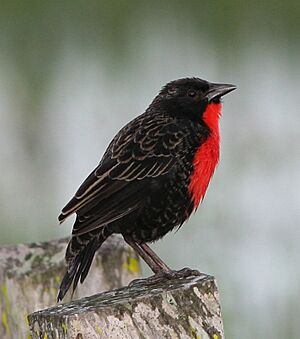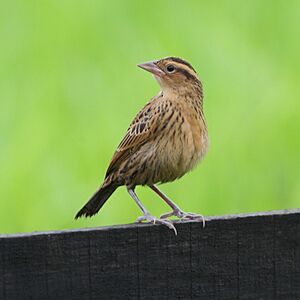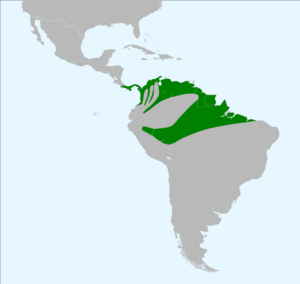Red-breasted meadowlark facts for kids
Quick facts for kids Red-breasted meadowlark |
|
|---|---|
 |
|
| male in the Llanos, Venezuela | |
 |
|
| female in Apiacás, Mato Grosso state, Brazil | |
| Conservation status | |
| Scientific classification | |
 |
|
| Synonyms | |
|
The red-breasted meadowlark (Leistes militaris) is a colorful passerine bird found in the New World. It belongs to the Icteridae family, which includes other birds like orioles and blackbirds. This bird used to be called the red-breasted blackbird, but scientists now know it's not closely related to the red-winged blackbird.
Contents
Understanding the Red-Breasted Meadowlark's Name
Scientists give every living thing a special two-part name. This helps everyone around the world know exactly which animal or plant they are talking about. The red-breasted meadowlark was first officially described in 1758. A famous Swedish scientist named Carl Linnaeus gave it the name Emberiza militaris.
Later, scientists learned more about this bird. They decided it fit better in a different group, so its name changed to Leistes militaris. The word militaris means "military" or "soldier-like." This name was chosen because of the male bird's bright red chest, which looks a bit like a soldier's uniform.
What Does a Red-Breasted Meadowlark Look Like?
The red-breasted meadowlark is a small bird. It is about 19 cm (7.5 in) long and weighs around 40–48 g (1.4–1.7 oz). Male birds are a bit bigger than females.
Male and Female Differences
- Males: The male red-breasted meadowlark has mostly black feathers. But it has a very bright red throat, belly, and patches on its wings. These red patches are called "epaulets." This striking red color is why it's sometimes called the "soldier bird."
- Females: Females look different. Their upper body feathers are dark brown with buff (light yellowish-brown) edges. Their underparts are buff with a hint of red. They also have pale streaks on their head and near their eyes.
- Young Birds: Young red-breasted meadowlarks look a lot like the females. However, they are usually paler and do not have as much of the reddish color on their undersides.
Comparing with Similar Birds
This bird is very similar to the white-browed meadowlark. That species lives further south. Male white-browed meadowlarks are easy to tell apart because they have a bright white stripe above their eyes. But the females of both species look almost the same! Female red-breasted meadowlarks have slightly longer beaks and are a bit smaller. They also have more red and fewer streaks on their underparts.
Where Do Red-Breasted Meadowlarks Live?
The red-breasted meadowlark lives in many parts of Central and South America. You can find them from south-western Costa Rica and Trinidad. Their range extends south to north-eastern Peru and central Brazil. They have recently started to live in new areas, like Costa Rica. In 2008, they were even seen for the first time in Nicaragua.
Their Favorite Places to Live
Like other meadowlarks, these birds prefer open areas. They like moist grasslands, pastures, and farms. They especially like places with a few bushes or fence posts. Males use these spots to sing their songs.
The red-breasted meadowlark has actually benefited from people clearing forests. This creates more open land for them. Because of this, they are spreading into new areas. It's not clear if the birds seen on Tobago live there all the time or just visit from Trinidad or South America.
Red-Breasted Meadowlark Behavior
Reproduction and Nesting
During the breeding season, the male red-breasted meadowlark performs a special display. He flies up to 10 m (33 ft) in the air. Then, he floats down with his wings folded while singing a unique, wheezing song. It sounds like ti-ti-pee-pee-KWAAAAAA. Their regular call is a short tsip.
These birds build their nests on the ground. The nest is a deep, cup-shaped structure made of grass. They often build several nests close together in tall grasses. A female usually lays two to four cream-colored eggs. These eggs have reddish-brown blotches.
What Do They Eat?
Red-breasted meadowlarks are social birds. They often feed in groups. Their main food is insects. They also eat some seeds, including rice. They look for food on the ground, much like a bobolink does.


